Issue #101: Fish Cakes and Democracy
Back from Tel Aviv, Where They Protest Well and Eat Well, A Recipe for Cod Cakes Braised in Tomato Sauce
Dear reader, my 100th issue promotion continues until June 30. Upgrade from a free subscription to a paid annual subscription before then to save 20% off the rate ($45 per year) and receive a free, signed copy of my cookbook Kitchen Sense: More than 600 Recipes to Make You a Great Home Cook (shipping charges will apply to mailing addresses outside the continental U.S.).
Please note that since launching this special offer I’ve learned the Substack platform does not make it possible to invoke the reduced rate when switching from a paid monthly to a paid annual subscription. To do so you have to cancel your monthly subscription and resubscribe at the annual rate. Apologies for any inconvenience. Thank you, as always, for your continued support.—Mitchell
I’m just back from Tel Aviv, where the work of exploring and nurturing the diverse food culture of Israel continues apace at Asif: Culinary Institute of Israel, with which I work. In the midst of the current political tensions about the future of Israel’s democracy, highlighting the potential power of food to bring people together feels as important as ever. Shortly after landing I attended my first Saturday night demonstration, week 17 of the resistance to the current right-wing government’s devolution toward autocracy. The diversity of Israel’s people is reflected on and around the table. If only the ruling party of the government were as open to that diversity as the restaurant menus around the country where they eat.
Of course, while in Israel I ate really well. Despite the palpable underlying mood of political despair and the impact of the demonstrations on Saturday night business—restaurants now close and theater shows start earlier so attendees can be out in time to protest—new and exciting restaurants continue to open. To experience them I barely had to leave a ten-block radius of my hotel, located across the street from Asif in Tel Aviv’s trendy Neve Tzedek neighborhood on the border of the even trendier Florentin.
One of the hottest seats in town is at Naifa, a new restaurant by Druze chef Naifa Mulla, whose modern take on the cooking of her heritage is totally worth the hype.
Aside: Click here for my guide to eating in Tel Aviv, usually a benefit restricted to paid subscribers, but available free to all thru June 30 in celebration of my 100th issue milestone. I’ll update my list with new finds in the coming weeks.
Another meal highlight was lunch at Ibn Ezra, a newish restaurant around the corner from Asif where Elran Scherpler’s culinary craft shines. This was my second visit. Elran is the son of the late Ezra Scherpler, who operated the beloved Azura in the Machne Yehuda market in Jerusalem for decades. Azura falls into the category of “workers canteen,” a simple, homey restaurant that fed laborers homecooked food to sustain them while they literally built the country.
These workers restaurants are the subject of fascinating exhibit on now at Asif that explores the history of and nostalgia for these canteens, as well as the current state of nourishment for Palestinian and immigrant workers in Israel today. As part of a package of articles commissioned by Asif about the phenomenon, Israeli journalist Hila Alpert wrote a beautiful oral history of the role food played for workers at the Machne Yehuda market, where in addition to wonderful food, Azura provided both comfort and respite from the daily grind of market life.
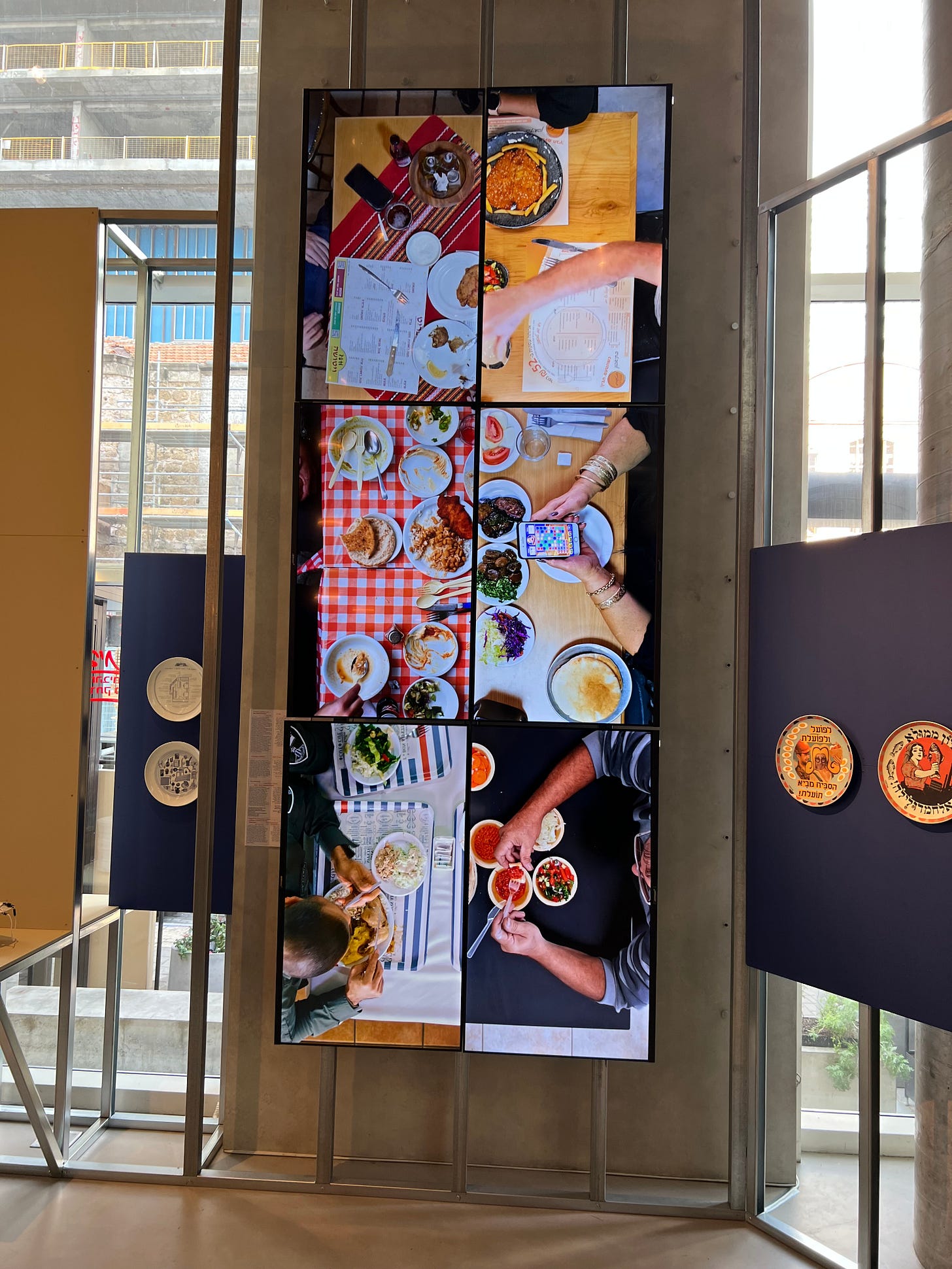
The quiet, contemplative Elran opened a branch of Azura in Tel Aviv in 2015, where he proved what many knew, that he was the most culinarly gifted offspring of the clan. He left the family business during the pandemic and opened Ibn Ezra in August 2022.
The dishes on Ibn Ezra’s menu may seem familiar, but there is something unique in his touch that makes everything he cooks transcendent. I mean everything, from the falafel and masabacha (warm, chunky hummus), which were both creamier and more flavorful here than just about anywhere else, to the traditional, deceptively homey, slow-cooked dishes that are the family’s signature. I once had a taste of Elran’s kubbeh, the Iraqi Jewish meat-filled semolina dumplings served in tangy broth, that made me reevaluate what I thought of any I’d had before. One of the standouts this time was mafrum, a Libyan Jewish dish of potatoes and other vegetables stuffed with meat, battered, fried, and then braised in a tangy tomato sauce. Amazing. Another was a sort of fish kabob braised in tomato sauce, a recipe for which I offer you in this week’s newsletter.
Below is not Elran’s recipe, rather it was inspired by the one I had there and informed by a recipe from Yotam Ottolenghi and Sami Tamimi’s Jerusalem cookbook, which I’ve made often. But like most of the recipes in the Ottolenghi series, I use them mostly for inspiration and almost never follow the recipes exactly as written.
As you should know by now, a recipe for me is usually a starting point for creativity and food-waste minimization. I want to use up things I’ve got rather than go out to buy everything I need. That has led me to use cooked rice as a binder in these fish cakes when I don’t have any stale white bread. I’ve used celery leaf instead of coriander, and now add some ever since. If I have a half a can of tomato paste drying out in the fridge, I’m not going to open a new can of tomatoes. Thin it with some stock and use it instead. Add a bunch of cooked, seasonal greens, some cooked chickpeas, these home-style recipes are meant to adapt.
After testing the recipe, we’ve been eating these fish cakes all week. I can tell you they keep well and get better as they sit. They are delicious served warm or at room temperature and even cold from the fridge.
RECIPE: Middle-Eastern Cod Cakes Braised in Tomato Sauce
(Makes 12 fish cakes, enough to serve 6 to 8)
For the Tomato Sauce
3 tablespoons extra-virgin olive oil
1 large onion, chopped
1/2 teaspoon kosher salt
1/2 small jalapeño or other hot pepper, seeded and minced
1 large clove garlic, minced
1 1/2 teaspoons ground, toasted cumin
1 teaspoon sweet paprika
1 teaspoon ground coriander
1/8 teaspoon ground cinnamon
1/2 cup dry white wine
One 14-ounce can peeled, chopped tomatoes or 1/3 cup tomato paste plus 1 cup light vegetable or other stock, kombu dashi, water, or other liquid
2 teaspoons sugar
1 bay leaf
Freshly ground black pepper
About 1/2 cup (2 ounces), blanched and chopped nettles, spinach, or Swiss chard (optional)
About 1/2 cup cooked chickpeas (optional)
For the Fish Cakes
1 medium onion, peeled and finely chopped
4 cloves garlic, roughly chopped
2 ounces cooked white rice, stale white bread (crusts removed and cubed), mashed potato, matzo meal, bread crumbs, or a combination
1 1/2 pounds fresh cod, hake, pollock, or halibut, skin and pin bones removed, diced
1 cup mixed fresh herbs, such as parsley, cilantro, dill, mint and/or celery leaf
1 tablespoon matzo meal or breadcrumbs (in addition to any used above)
1 tablespoon ground, toasted cumin
1 1/2 teaspoons kosher salt
2 large eggs
Freshly ground black pepper
4 or 5 tablespoons extra-virgin olive oil
1 cup light vegetable or other stock, kombu dashi, water, or other liquid
Chopped fresh mint, parsley, dill, and/or cilantro, for garnish
For the tomato sauce, heat the olive oil in a large sauté pan that has a tight-fitting lid over medium-high heat. Add the onion and salt and sauté until the onion begins to soften, about 4 minutes. Add the jalapeño and garlic and continue sautéing another minute or so. Add the cumin, coriander and cinnamon, and sauté until the spices are nicely toasted and the onions are soft, another 5 minutes or so. Add the white wine and scrape the bottom of the pan while the wine simmers to remove any goodness that has stuck. Add the chopped tomato or combination tomato paste and stock, sugar, bay leaf and a good bit of freshly ground black pepper, and stir to combine. Reduce the heat as low as it will go, cover the pan, and simmer for about 7 minutes. Add the chopped nettles, spinach, or chard, and/or chickpeas, if using, cover and simmer another 5 minutes, or until the sauce is nicely thickened. Taste and adjust the seasoning. Set aside.
For the fish cakes, place the onion and garlic in a food processor fitted with a metal chopping blade and pulse until finely chopped, scraping down the sides once or twice to assure even chopping. Add the rice or bread and continue pulsing to grind. Add the fish, herbs, additional tablespoon of matzo meal or bread crumbs, cumin, salt, eggs, and black pepper. Pulse until the mixture is chopped and well mixed. Don't over process to a paste; you should still see some small pieces of fish. Keeping your hands wet with cold water, shape about 1/3 cup of the fish mixture into patties and set on a clean plate (I get about 12 patties), cover with plastic wrap and refrigerate until ready to fry.
Place the pan with the tomato sauce over low heat. In another large, nonstick pan heat a couple of tablespoons of the olive oil over medium-high heat. Once the oil is hot, add four or five fish cakes to the hot oil, being sure not to crowd them so they sear. Fry until nicely browned, 4 or 5 minutes, and then carefully flip to sear the second side. Once the second side is brown, transfer the patties to the pan with the tomato sauce. Don't worry that they won't be fully cooked through; they will be finished in the sauce. Fry the remaining patties and transfer to the pan with the others. It's okay to crowd this pan a little, they can touch, as long as you don't break up the cakes. When all of the fish cakes are fried and in the sauce, add the stock or other liquid to the pan, bring the liquid to a simmer, reduce the to as low as it will go, cover, and let cook for 15 to 20 minutes, until the sauce is thick and rich and the fish is cooked through.
You can serve this dish hot or at room temperature, garnished with a handful of chopped mint and/or other herbs. The fish cakes can be made in advance and stored up to four days. bring back to room temperature or warm over gentle heat, adding a little more liquid if necessary to loosen the sauce.
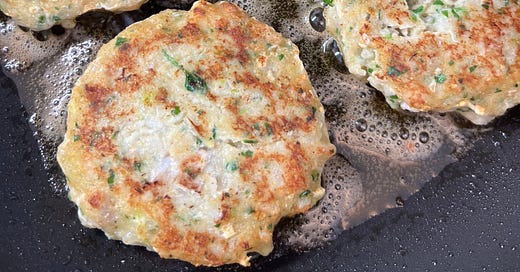




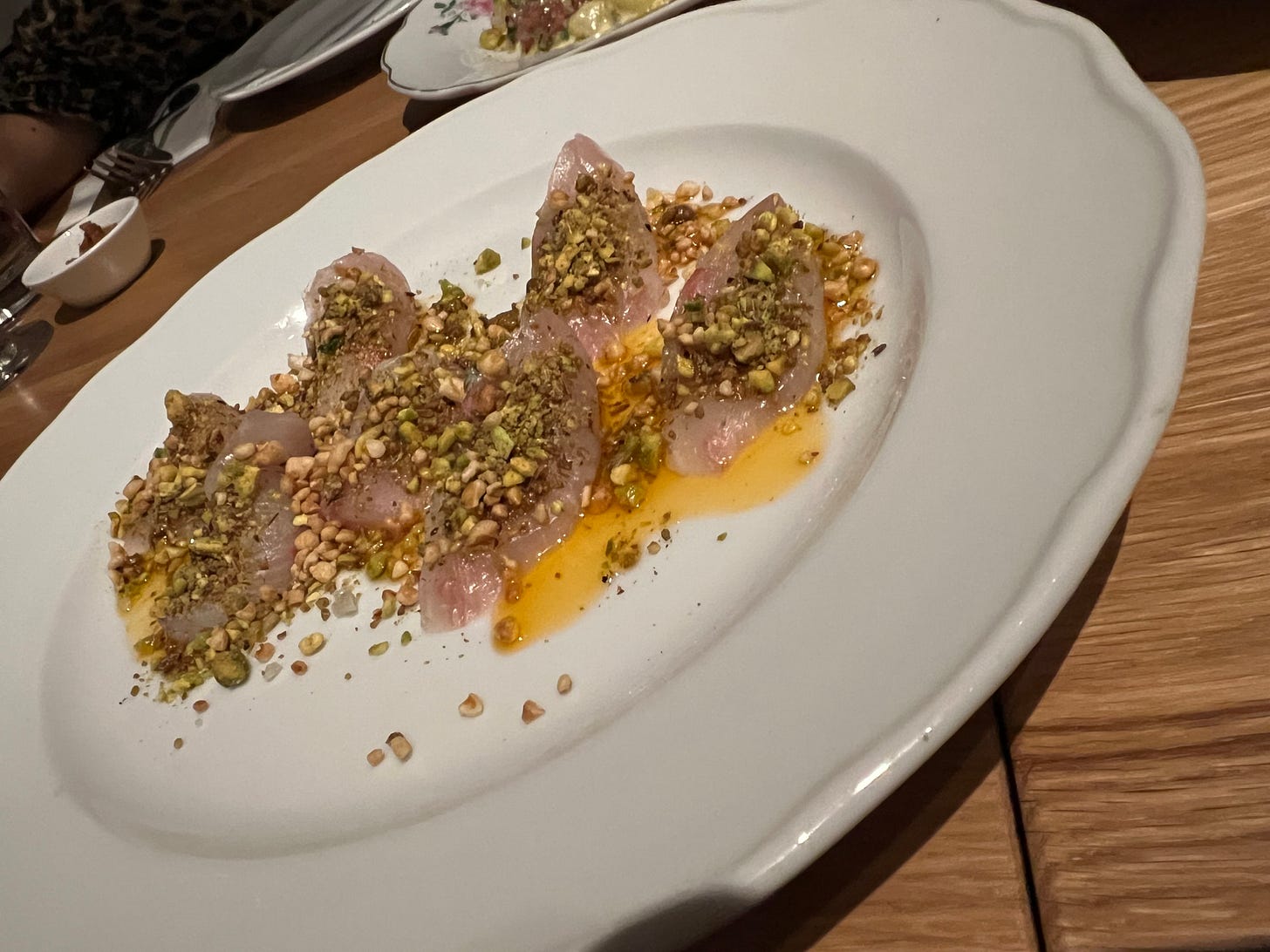

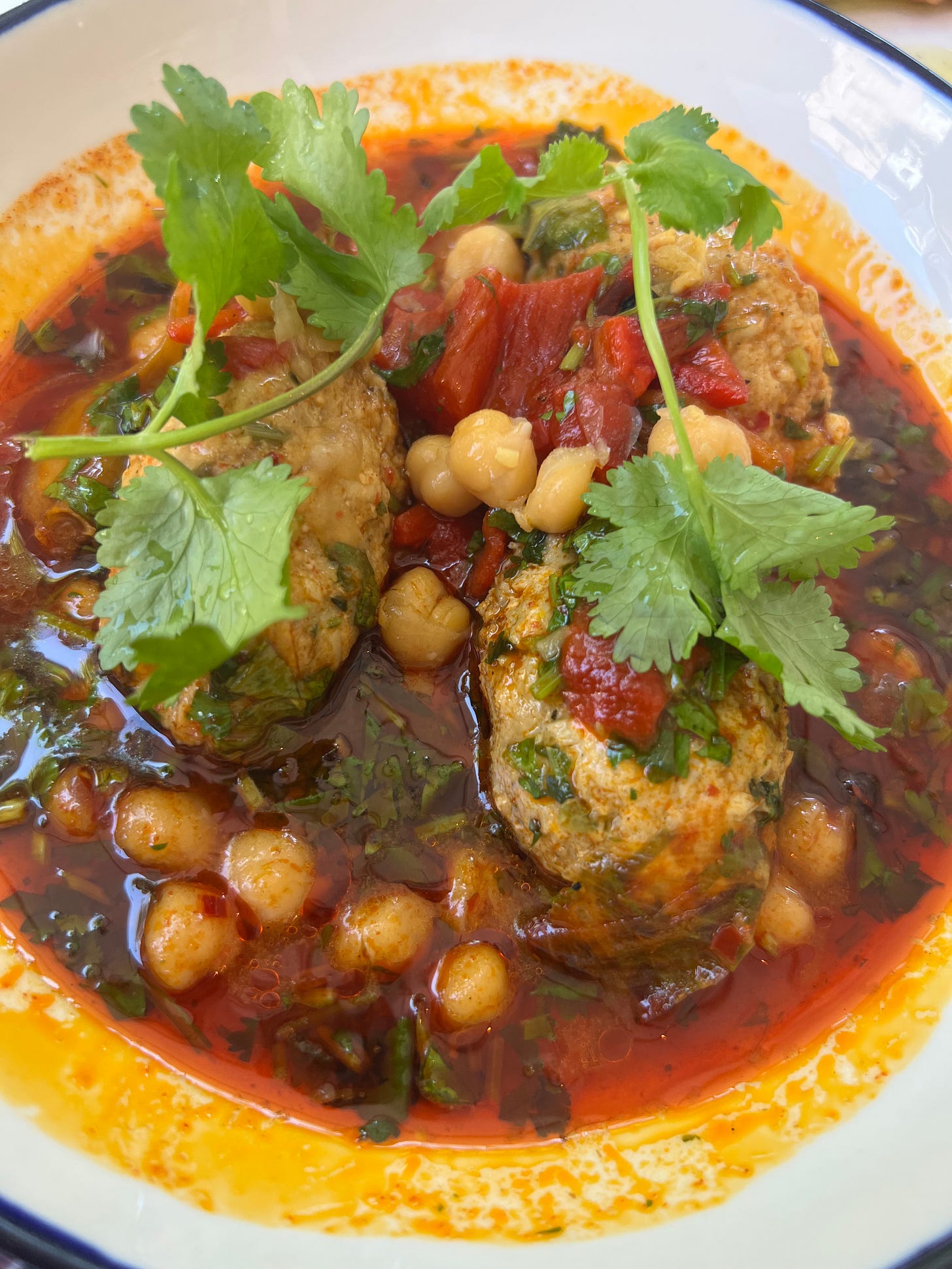
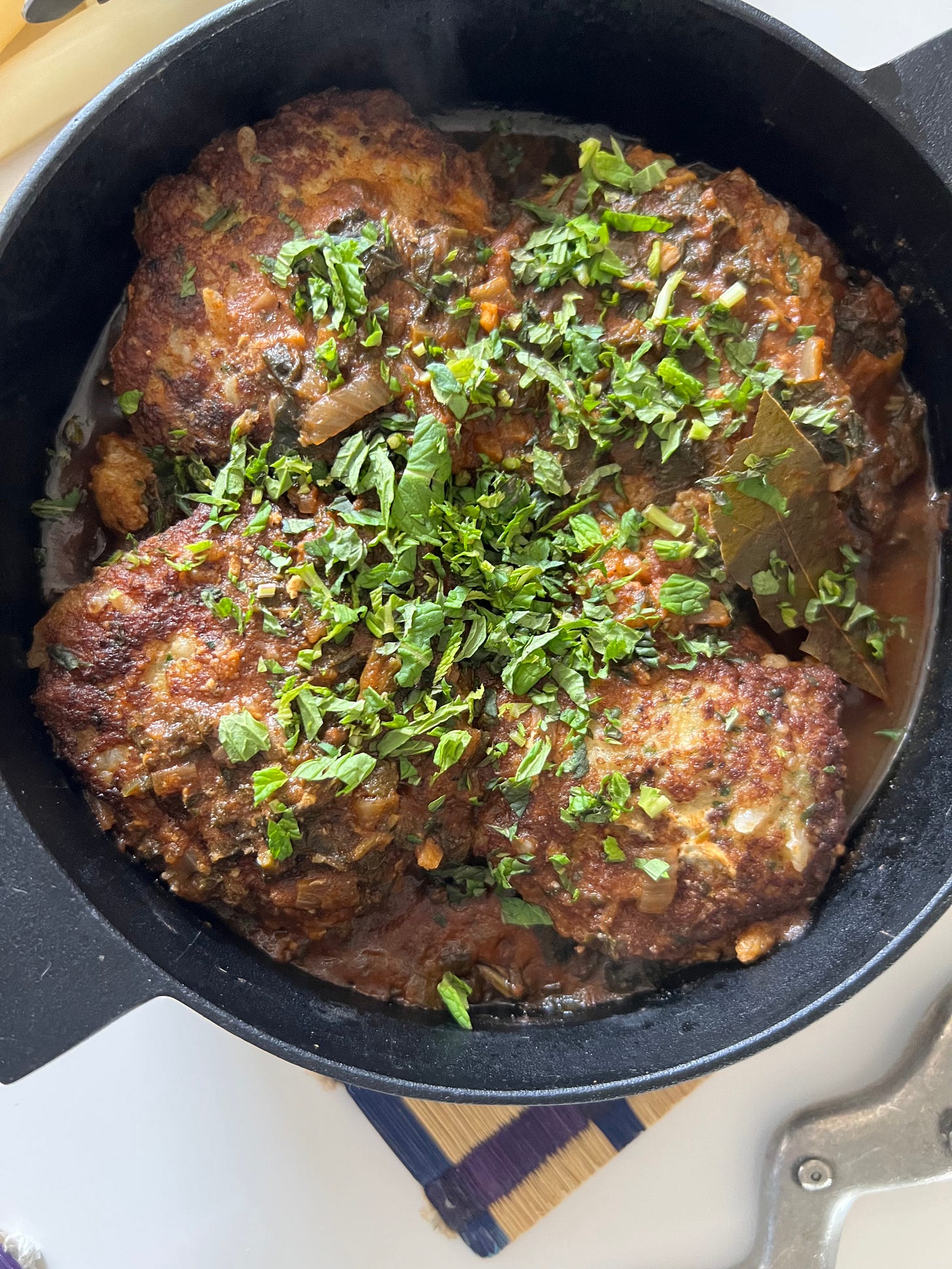
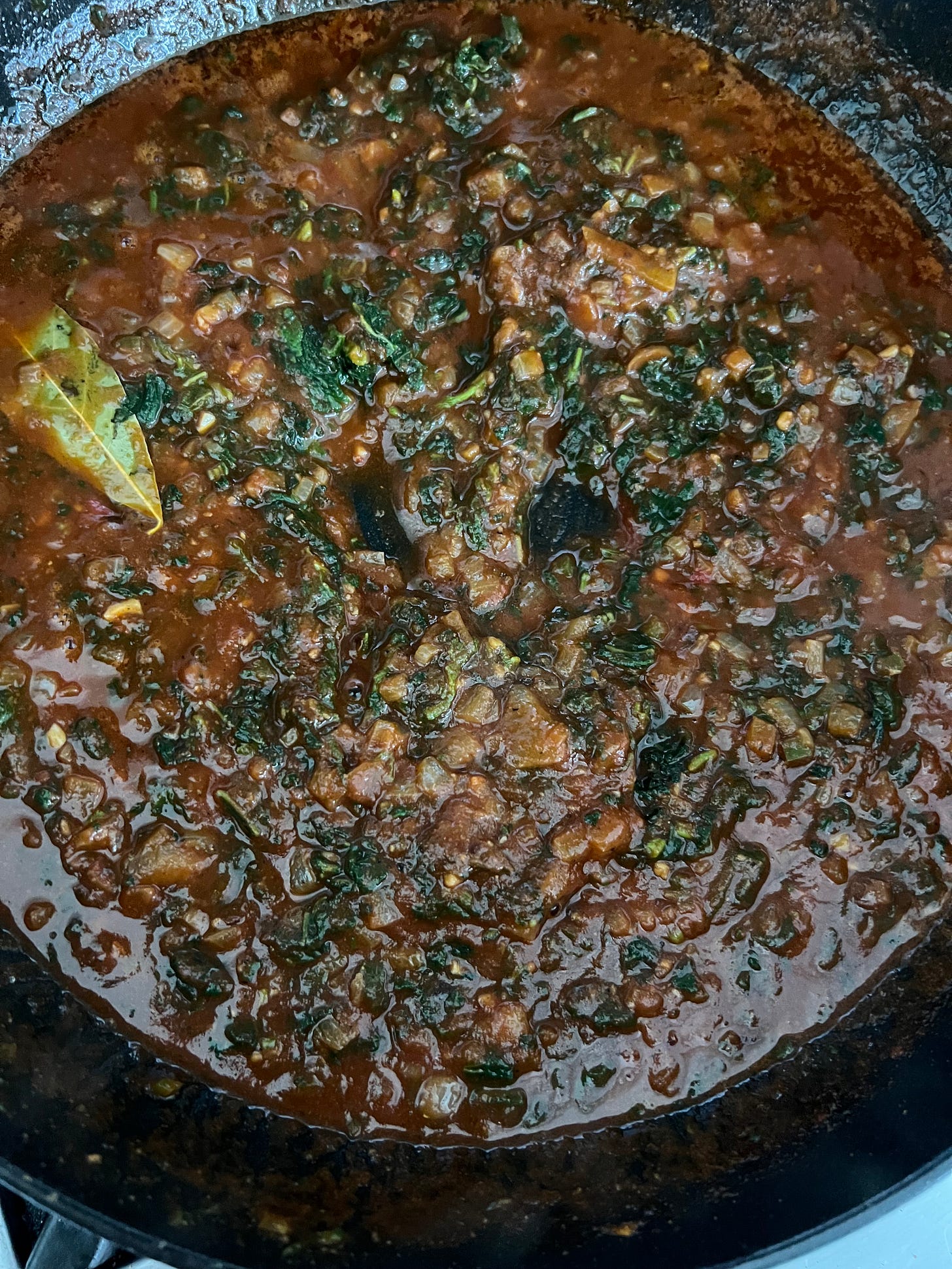



Hi Marcia. Yes, I'm happy to send current paid subscribers a copy of the book to show my appreciation. All you'll have to do is pay for shipping and handling, which comes to $8.50. You can Venmo or PayPal it to me. Shoot me an email with shipping information and tell me to whom I should sign it.
How can current subscribers take advantage of your book offer? I’d like to send a copy to a friend recently widowed and learning to
cook. Marcia Kelly